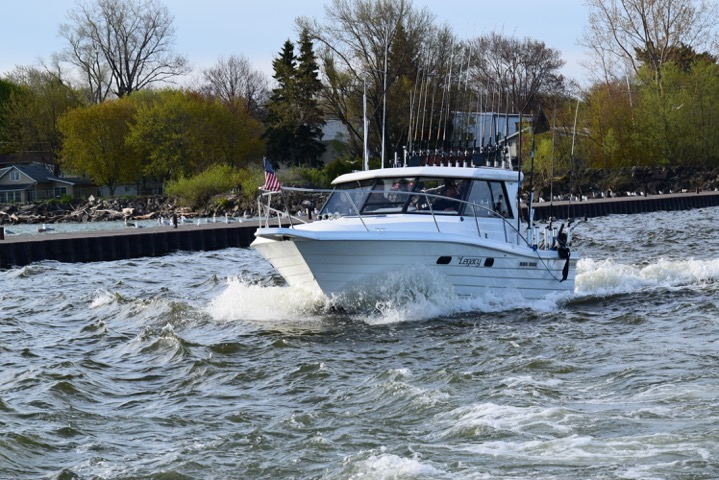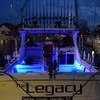-
Posts
7,579 -
Joined
-
Last visited
Content Type
Profiles
Forums
Events
Gallery
Store
Posts posted by Legacy
-
-
-
I have always run them up until last year. i had another one break do to dry rot so im done with them.
-
-
A disinfection solution currently used for salmon eggs also prevents transmission of the virus that causes viral hemorrhagic septicemia (VHS) in other hatchery-reared fish eggs, according to new US Geological Survey (USGS)-led research.
One of the most dangerous viral diseases of fish, VHS has caused large mortalities in wild fish stocks in the US and especially in the Great Lakes region, where thousands of fish have died from the virus over the last few years. The disease causes internal bleeding in fish yet is not harmful to humans.
The virus has thus far been detected in over 25 species of fish in Lakes Michigan, Huron, Erie, St Clair, Superior and Ontario, as well as the Saint Lawrence River and inland lakes in New York, Michigan and Wisconsin states.
Effective disinfection methods are crucial to natural resource agencies that collect eggs from wild fish stocks and private aquaculture because the spread of the virus to a fish hatchery could be devastating, said Mark Gaikowski, a USGS researcher who led the USGS and US Fish and Wildlife Service (USFWS) research team.
“If VHS virus is introduced into the aquaculture industry, it could lead to trade restrictions, as well as direct economic losses from the disease,†he observed.
USGS and USFWS researchers tested the effectiveness of using iodophor disinfection in walleye and northern pike eggs and found that it eliminated the active virus from fertilized eggs. Iodophor disinfectant solutions contain iodine formulated for use on fish eggs.
The researchers also found that, although some disinfection treatments reduced hatch, iodophor treatment at 90 minutes after fertilization occurred did not alter egg hatch or fry development.
Experts worry the virus could spread from the Great Lakes into new populations of native fish in the 31 states of the Mississippi River basin. Regulatory agencies in the US and Canada have already placed restrictions on the movement of fish or fish products that could pose a risk for the spread of VHS to regions beyond the known geographic range.
The research was funded by the USGS and the North Central Regional Aquaculture Centre (NCRAC) from the US Department of Agriculture Cooperative State, Research, Education and Extension Service. The iodine used during egg disinfection was donated by Western Chemical Inc, Ferndale, Washington.
Heres some good info: http://pubs.usgs.gov/fs/2009/3107/pdf/fs20093107.pdf
-
I would run any color you want as long as its black.
-
Too bad they are protected. The DEC is going forward with their cormorant study this year rather than waiting till next year. Without a "study" they wont address the problem. The good news is it should put the problem in the spotlight and the state and feds will act on the issue sooner.
-
Good book to own. it will really take some of the guess work out of fishing.
-
All this talk on energy is really making me more and more pro nuclear.
-
Sandy Creek pen rearing meeting. We are having a short meeting to start off this years project and for new updates. The meeting will be at the Hamlin Town Hall in the gymnasium at 2:30pm, this Saturday, March 6, 2010. All are welcome to attend.
-
Last time i was in there they had 2 different styles for sale.
Mitchels Live Bait and Tackle
(585) 663-4564
4531 Lake Ave
Rochester, NY 14612
-
Scotty Tournament Series
Wilson- May 8,9
Oswego- August 21,22
2010 Lake Ontario ProAm dates
Niagara County June 5-6
Orleans County June 12-13
Oswego County July 10-11
Wayne County July 17-18
-
Dump the mono backing and use 50# power pro for backing. Like going deep said, use a haywire twist to connect copper to small spro inline swivel to connect to leader and to your backing. http://www.atommiktrollingflies.com/swivels.htm
-
Makes complete sense now, thanks. LOL!
-
Happy Birthday Jason!
-
No, not at all. Alot of team members work fridays and show up for sat and sun. Alot of teams also let their observer fish with them on friday.
-
Good Time!

-
green, chart, white, glow small perch jigs
-
Welcome to the site!
-
-
STATUS:
S6453 LIBOUS No Same as
Environmental Conservation Law
TITLE....Authorizes an individual to angle for fish with up to 3 lines
01/13/10 REFERRED TO ENVIRONMENTAL CONSERVATION
--------------------------------------------------------------------------------
SUMMARY:
LIBOUS
Amd S11-0103, En Con L
Authorizes an individual to angle for fish with up to three lines.
--------------------------------------------------------------------------------
BILL TEXT:
STATE OF NEW YORK
________________________________________________________________________
6453
IN SENATE
January 13, 2010
___________
Introduced by Sen. LIBOUS -- read twice and ordered printed, and when
printed to be committed to the Committee on Environmental Conservation
AN ACT to amend the environmental conservation law, in relation to
authorizing angling by a single individual with up to three lines
The People of the State of New York, represented in Senate and Assem-
bly, do enact as follows:
1 Section 1. Subparagraph 2 of paragraph b of subdivision 12 of section
2 11-0103 of the environmental conservation law, as amended by chapter 215
3 of the laws of 1995, is amended to read as follows:
4 (2) one person may operate not more than [two] three lines, with or
5 without rod;
6 § 2. This act shall take effect immediately.
EXPLANATION--Matter in italics (underscored) is new; matter in brackets
[ ] is old law to be omitted.
LBD15326-01-0
--------------------------------------------------------------------------------
SPONSORS MEMO:
NEW YORK STATE SENATE
INTRODUCER'S MEMORANDUM IN SUPPORT
submitted in accordance with Senate Rule VI. Sec 1
BILL NUMBER: S6453
SPONSOR: LIBOUS
TITLE OF BILL:
An act to amend the environmental conservation law, in relation to
authorizing angling by a single individual with up to three lines
PURPOSE:
This legislation would authorize an individual to angle for fish with up
to 3 lines.
SUMMARY OF PROVISIONS:
Amends section 11-0103 of the Environmental Conservation Law to change
the number of lines one person may operate from not more than two to not
more than three, with or without rod.
JUSTIFICATION:
This new 3-rod rule is designed to favorably impact a fisherman's expe-
rience by increasing his probability of catching a fish. Catching a fish
enhances angler satisfaction more than any other factor and is the prime
determinant in deciding whether or not to make return visits to the
fisheries of New York.
Return visits to the fishery are a boon to the local economies. Return
trips mean more money spent locally for fuel, food, lodging, launches,
parking, and rentals.
The 3-rod rule will not guarantee that people catch more fish; rather it
will give them the potential to locate the fish a little easier. The
small crewed boats, the 'weekend warrior', the recreationalist, the
vacationer, the retired couple who have saved up for a boat and now have
the time and health to use it will all benefit from this.
It does not mean they must use 3 rods, it will mean they can use 3 rods
per person, whether they are operated from land or from a boat, if they
so choose. New Jersey and Michigan both have a 3-rod rule, to which they
have continued to see a favorable impact to their recreational fisher-
man.
In addition, the 3-rod rule will not exploit the fishery since exploita-
tion is constrained by creel limits that would still be in effect.
LEGISLATIVE HISTORY:
New bill.
FISCAL IMPLICATIONS:
None.
EFFECTIVE DATE:
Immediately.
-
Pretty ugly out there. Bite wasnt very good. Nothing on tip downs and only some small fish jigging.
-
HAPPY BIRTHDAY!

-
For instance if Jerry Felluca can't catch any fish on his boat and really wants to add to his long list of ESLO/LOC wins he CANNOT go to Gary Begy and beg him to take him out and enter them under the Rebel boat name. A: Gary would have to be registered and B: No way would Gary put "Rebel Charters" on anything. This is a hypothetical situation because it's been a while since I have seen Gary on the leaderboard.
Thats the funniest thing ive heard all year.
-
Id like to hook the one tailing in the last picture!



Fishing Derbies
in Open Lake Discussion
Posted
If derbys and tournaments are what it takes for anglers to show a major interest in our fishery then the more the merrier. With angler numbers and the number of angler trips falling, we need all the promotion and support we can get these days.